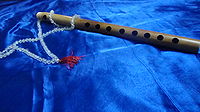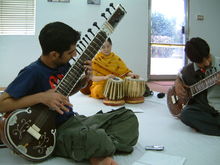In its most basic form, a flute can be an open tube which is blown like a bottle. There are several broad classes of flutes. With most flutes, the musician blows directly across the edge of the mouthpiece. However, some flutes, such as the whistle, gemshorn, flageolet, recorder, tin whistle, tonette, fujara, and ocarina have a duct that directs the air onto the edge (an arrangement that is termed a "fipple"). These are known as fipple flutes. The fipple gives the instrument a distinct timbre which is different from non-fipple flutes and makes the instrument easier to play, but takes a degree of control away from the musician.
Another division is between side-blown (or transverse) flutes, such as the Western concert flute, piccolo, fife, dizi, and bansuri; and end-blown flutes, such as the ney, xiao, kaval, danso, shakuhachi, Anasazi flute, and quena. The player of a side-blown flute uses a hole on the side of the tube to produce a tone, instead of blowing on an end of the tube. End-blown flutes should not be confused with fipple flutes such as the recorder, which are also played vertically but have an internal duct to direct the air flow across the edge of the tone hole.
Flutes may be open at one or both ends. The ocarina, xun, pan pipes, police whistle, and bosun's whistle are closed-ended. Open-ended flutes such as the concert flute and the recorder have more harmonics, and thus more flexibility for the player, and brighter timbres. An organ pipe may be either open or closed, depending on the sound desired.
Flutes may have any number of pipes or tubes, though one is the most common number. Flutes with multiple resonators may be played one resonator at a time (as is typical with pan pipes) or more than one at a time (as is typical with double flutes).
Flutes can be played with several different air sources. Conventional flutes are blown with the mouth, although some cultures use nose flutes. The flue pipes of organs, which are acoustically similar to duct flutes, are blown by bellows or fans.
[edit]Western concert flutes
Main article: Western concert flute
The Western concert flute, a descendant of the 19th-century German flute, is a transverse flute that is closed at the top. An embouchurehole is positioned near the top, across and into which the player blows. The flute has circular tone holes, larger than the finger holes of its baroque predecessors. The size and placement of tone holes, the key mechanism, and the fingering system used to produce the notes in the flute's range were evolved from 1832 to 1847 by Theobald Boehm, and greatly improved the instrument's dynamic range and intonation over those of its predecessors.[31] With some refinements (and the rare exception of the Kingma system and other custom adapted fingering systems), Western concert flutes typically conform to Boehm's design, known as the Boehm system. Beginner's flutes are normally made of nickel, silver or brass which is silver plated, while professionals use solid silver, gold, and sometimes platinum instruments. There are also modern wooden bodies instruments usually with silver or gold keywork. The wood is usually African Blackwood.
The standard concert flute is pitched in the key of C and has a range of three octaves starting from middle C (or one half-step lower, when a B foot is attached to the instrument). This means that the concert flute is one of the highest common orchestral instruments, with the exception of the piccolo, which plays an octave higher. G alto and C bass flutes are used occasionally, and are pitched a perfect fourth and an octave below the concert flute, respectively. Parts are written for alto flute more frequently than for bass[citation needed]. The contrabass, double contrabass, andhyperbass are other rare forms of the flute pitched two, three, and four octaves below middle C respectively.
Other sizes of flutes and piccolos are used from time to time. A rarer instrument of the modern pitching system is the treble G flute. Instruments made according to an older pitch standard, used principally in wind-band music, include Db piccolo, soprano flute (the primary instrument, equivalent to today's concert C flute), F alto flute, and Bb bass flute.
[edit]Indian flutes
The bamboo flute is an important instrument in Indian classical music, and developed independently of the Western flute. The Hindu God Krishna is traditionally considered a master of the bamboo flute. The Indian flutes are very simple compared to the Western counterparts; they are made of bamboo and are keyless.[32]
Pannalal Ghosh, a legendary Indian flutist, was the first to transform a tiny folk instrument to a bamboo flute (32 inches long with seven finger holes) suitable for playing traditional Indian classical music, and also to bring to it the stature of other classical music instruments. The extra hole permitted madhyam to be played, which facilitates the meends (like M N, P M and M D) in several traditional ragas.[citation needed]
Pandit Raghunath Prasanna developed various techniques in the realm of flute playing so as to faithfully reproduce the subtleties and nuances of the Indian classical music. In fact, he was responsible to provide a strong base to his Gharana by training his own family members. Disciples of the family like Pt. Bhola nath Prasanna, Pt. Hari Prasad Chaurasia, Pt. Rajendra Prasanna globally known for their melodious music.
Indian concert flutes are available in standard pitches. In Carnatic music, the pitches are referred by numbers such as (assuming C as the tonic) 1 (for C), 1½ (C#), 2 (D), 2½ (D#), 3 (E), 4 (F), 4½ (F#), 5 (G), 5½ (G#), 6 (A), 6½ (A#) and 7 (B). However, the pitch of a composition is itself not fixed and hence any of the flutes may be used for the concert (as long as the accompanying instruments, if any, are tuned appropriately) and is largely left to the personal preference of the artist.[citation needed]
Two main varieties of Indian flutes are currently used. The first, the Bansuri, has six finger holes and one embouchure hole, and is used predominantly in the Hindustani music of Northern India. The second, the Venu or Pullanguzhal, has eight finger holes, and is played predominantly in the Carnatic music of Southern India. Presently, the eight-holed flute with cross-fingering technique is common among many Carnatic flutists. Prior to this, the South Indian flute had only seven finger holes, with the fingering standard developed by Sharaba Shastri, of the Palladam school, at the beginning of the 20th century.[33]
The quality of the flute's sound depends somewhat on the specific bamboo used to make it, and it is generally agreed that the best bamboo grows in theNagercoil area in South India.[34]
[edit]Chinese flutes
In China there are many varieties of dizi (笛子), or Chinese flute, with different sizes, structures (with or without a resonance membrane) and number of holes (from 6 to 11) and intonations (different keys). Most are made of bamboo, but can come in wood, jade, bone, and iron. One peculiar feature of the Chinese flute is the use of a resonance membrane mounted on one of the holes that vibrates with the air column inside the tube. It gives the flute a bright sound.
Commonly seen flutes in the modern Chinese orchestra are the bangdi (梆笛), qudi (曲笛), xindi (新笛), and dadi (大笛). The bamboo flute played vertically is called the xiao (簫), which is a different category of wind instrument in China.
[edit]Japanese flutes
The Japanese flute, called the fue, 笛 (hiragana: ふえ), encompasses a large number of musical flutes from Japan, both of the end-blown and transverse varieties.
[edit]Sodina and suling
| This section does not cite anyreferences or sources. |
The sodina is an end-blown flute found throughout the island state of Madagascar, located in the Indian Ocean off southeastern Africa. One of the oldest instruments on the island, it bears close resemblance to end-blown flutes found in Southeast Asia and particularly Indonesia, where it is known as the suling, suggesting the predecessor to the sodina was carried to Madagascar in outrigger canoes by the island's original settlers emigrating from Borneo. An image of the most celebrated contemporary sodina flutist, Rakoto Frah (d. 2001), was featured on the local currency.
[edit]Sring
The sring (also called blul) is a relatively small, end-blown flute with a nasal tone quality[35] and the pitch of a piccolo,[citation needed] found in the Caucasus region of Eastern Armenia. It is made of wood or cane, usually with seven finger holes and one thumb hole,[35] producing a diatonic scale. The sring is used by shepherds to play various signals and tunes connected with their work, and also lyrical love songs called chaban bayaty, as well as programmatic pieces.[citation needed] The sring is also used in combination with the def and the dohl to provide music for dancing.[citation needed] One Armenian musicologist believes the sring to be the most characteristic of national Armenian instruments.[36]







